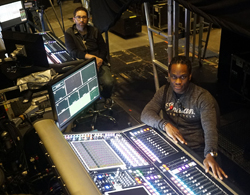
Co-headliner musical tours often bring challenges of balancing two sets of talented egos used to doing things their own way, right down to how their live sound is mixed and presented. But in the case of Chris Brown and Trey Songz’ shared 24-date North American “Between The Sheets Tour,” artists and crews from both camps have unanimously agreed on one thing: DiGiCo mixing consoles in monitor world.
Brown’s monitor engineer, William “Chainey” Harpe, and Songz’ monitor engineer, Adam Robinson, have been on each other’s professional radar for years, but this is the first tour that they have worked on together. Both DiGiCo fans who learned their craft on the manufacturer’s boards since being live sound novices, Harpe and Robinson were more than pleased to find DiGiCo SD7 consoles for monitors on Eighth Day Sound’s rig list for the trek.
Before hitting the road, it was decided that Songz would open the show for approximately 25 minutes, and then Brown would take over for the same duration. The two headliners would then share the stage for a set of songs back and forth, followed by a song together. To end the show, each artist would do another set on his own.
“The biggest challenge was coming up with a comprehensive plan that would address two bands on stage at the exact same time and the need to have continuous mixes back and forth,” notes Robinson, who’s been mixing for Songz and his band for a little more than four years.
Initially, each act’s crew ran through its own rehearsals for about a week. The engineers then combined their desks and for a day-and-a-half ran through the possibilities, ultimately combining rehearsals with the artists and bands for another three days. “Once we brought our systems together,” he adds, “we were off and running really well in what could potentially be a really, really complicated operation.”
Robinson started music rehearsals with the Songz band on a DiGiCo SD5 nearly a month before merging his rig with Harpe’s. “With the conversion software, I took those mixes I had built for the band and converted up to SD7,” Robinson explains. “When we started the full band and production, I was ready to go for all the new stuff we were going to do.”
Regarding how the preparation paid off, Harpe notes: “Adam and I had some brief conversations on how it was going to lay out, and he had it all thought out in his head and on paper. I guess I was a little skeptical at first; it looked like either a walk in the park or a complete nightmare because it sounded too simple. But we basically set up, fired it up, started running some tests and never looked back.”
Harpe, who has a decade of experience handling Brown’s monitors since the singer was 15 years old, credits Robinson with doing the “heavy lifting” in figuring out what product to use and how to manage it. “His thinking was ‘you’ll have everything I have and I’ll have everything you have,’” Harpe adds.
While the front of house engineers on this tour share a handful of inputs by way of some very intricate cross-patching, things are much different in monitor world thanks to both SD7 consoles and all racks—two SD Racks and two SD Mini Racks—being on one Optocore loop. A total of 136 inputs run between the racks on the network, and both engineers also have four local inputs in use. Harpe’s rig has 45 outputs while Robinson’s setup has 38 outputs.
By sharing sidefill arrays, the engineers utilize Optocore send/receive lines to receive sidefill outputs to each desk, also enabling back and forth talkback mics on those tie lines.
Robinson’s pre-tour maps and channel layouts were helpful. “Everything lined up perfectly,” comments Robinson, who has been using DiGiCo since the mid-2000s. “The first desk I ever took out on tour was a D1, and then a D5. DiGiCo is usually the first thing on my list of requests.” At one time or another, the engineer notes that he has used “pretty much every console that DiGiCo has made” on the road.
“Sometimes, in what we do, you gotta take what you gotta take,” Robinson continues. “But DiGiCo, for me, is still home, the desk I’m most comfortable on. In monitor world, the way I like to mix, there’s nothing as flexible. In this gig especially, I can’t think of any other desk that could have handled the number of inputs and outputs. The console makes it so effortless. And the ergonomics make it so easy for us both to access and utilize everything so well.”
Their familiarity with each other’s work also ensured a smooth ride. “I’ve had Adam cover for me, and vice versa, and we’ve been on radio shows where I have an act I’m taking care of and so does he. But it’s never been in this capacity [working the same tour the same time],” says Harpe, admitting that he never before tried fiber-optic connections between two consoles. “I always knew Adam’s skillset and what he brought to the table. I was more than eager to give it a shot and it’s really worked great.”
